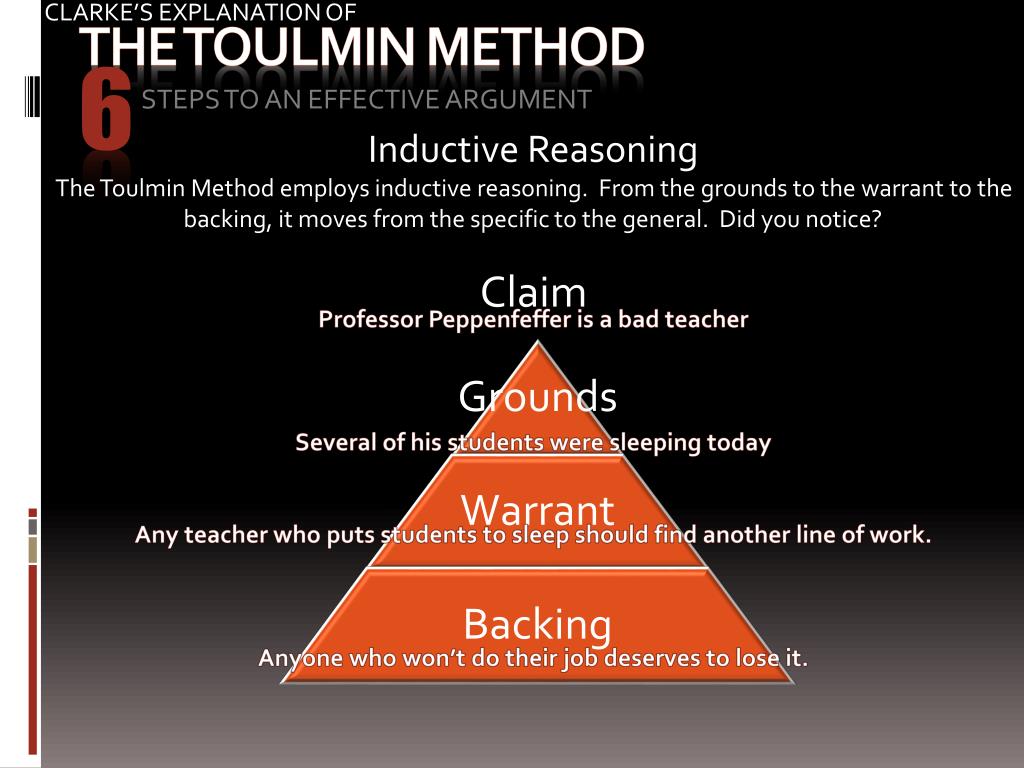Toulmin Method
| Image courtesy of visualcommunicationguy.com. |
The Toulmin Method offers its adherents a structured framework, from which one can fully analyze or construct an argument. These are the characterized six “parts” of the argument model; however, we will lump them together into a two-part format. Part one consists of claim/grounds/warrant, with “part two” entailing backing/qualifier/rebuttal. We will briefly examine these components and identify their significance to a logical argument. The “claim” is our principal argument (Indeed.com), this is what we are asking the audience to either accept as true or to act accordingly with our findings. Next come our grounds and warrant, all of which provide evidence as to why we are making our claim and link it all together for the audience. The backing is any additional supporting evidence we can provide to our premise/claim. Qualifiers, show that our “claim may not be true in all circumstances.” (Indeed.com) Finally, we arrive at rebuttal, the section where we address and acknowledge any opposing viewpoints to our claim. This methodology provides the author with a framework to structure their argument, so it has the best logical chance of affecting the targeted audience.
Toulmin Analysis provides us a means to effectively (analyze) premises in an extremely detailed manner, as we are provided with the format to do this in. It is a constructed form, of four centrally themed ideas, from which a multitude of various sub-steps are then presented to the analyzer, as to further examine a suggested premise within furthering degrees of detail. The Toulmin Analytical Method is formulated from logical and reasoned steps, that look to deconstruct one’s asserted premise into well-organized thought constructs. These “chunks” can be dissected and researched to ever finer degrees of detail whilst using Toulmin’s methodological format.
In a brief summation of Communicating Online (4th ed.), we can further define these analytical steps. Firstly, we must analyze the claim, which is denoted by three distinct stages: find the claim/look for qualifiers/look for explicit exceptions to the claim. (325) This series of investigative steps are mostly centered on identifying the author’s thesis (claim).
Secondly, we analyze the reasons and evidence. In this phase
we are again provided with three distinct steps for analysis: find the reason
or reasons offered to justify the claim/for each reason, locate all evidence offered
to back it up/consider each piece of evidence. (325) It is through these stages/steps
that we are looking for the supporting data/evidence to back the author’s claims.
It is noted that all reasons require extensive evidence…however, we should be
suspicious of reasons without evidence. (325) This “evidence” can
consist of things such as case studies, authoritarian statements on the matter,
etc.
Thirdly, we are asked to consider the warrant or warrants
for each reason. (325) In this step
of the process, we assess “unstated” beliefs that act as connections to each of
the claims. Finally, we look for counterarguments and/or rebuttals. As we can
see the Toulmin Method is a structured way of forecasting a premise into a
designated framework as means for analysis. It is a tool that provides us a
method, to be utilized in our aims of defining and assessing the validity of an argument. It can also be employed by the writer of such arguments, as an
additional means of reassuring the solidity of the premises being asserted in
any given argument. It thereby acts as a legitimate format in the crafting and
analysis of argued premises. These benefits are made obvious by Indeed's inclusion of this methodology in their career development blog aimed at prospective job-seekers.
 |
| Image courtesy of SlideServe. |
Let us now look at Toulmin's Method in a real-world scenario from the headlines, Russia preparing a massive offensive soon to be released in Ukraine?
Our claim states that there may well be a "massive offensive" posed by the Russian Federation of Forces against residents of Ukraine.
The grounds state, that the Russian Army has been supplemented by the activation of 300,000 additional reserve troops.
The warrant states, the first "initial thrust" into Ukraine took place in 2014 with far fewer troops than are currently mobilized.
The backing states, Russia remains open and willing to negotiate, however, it deems these efforts as useless under the current Zelensky regime of Ukraine.
Works Cited
Green, J. (2022). Communicating
Online. McGraw-Hill Create.
https://bookshelf.vitalsource.com/books/9781307755855.
Indeed. (11th October 2022). Toulmin Argument Model:
Benefits, Parts and Examples. Career Development. Indeed Editorial Team.
Indeed.com
Toulmin
Argument Model: Benefits, Parts and Example | Indeed.com
Lefcourt, D. (15th November 2022). Russia Preparing a Massive Offensive Soon To Be Unleashed in Ukraine? Opednews.com
Article: Russia preparing a massive offensive soon to be unleashed in Ukraine? | OpEd News

Comments
Post a Comment